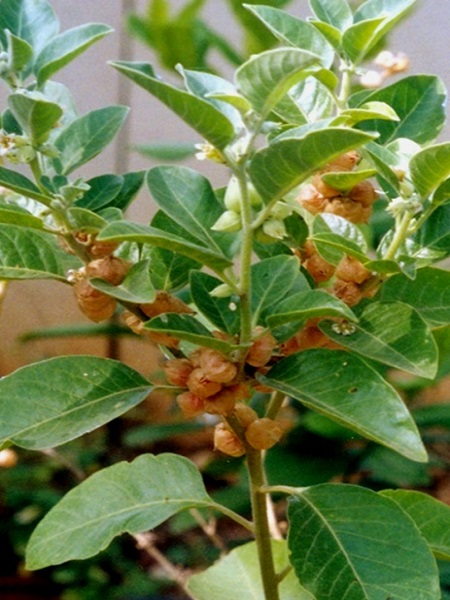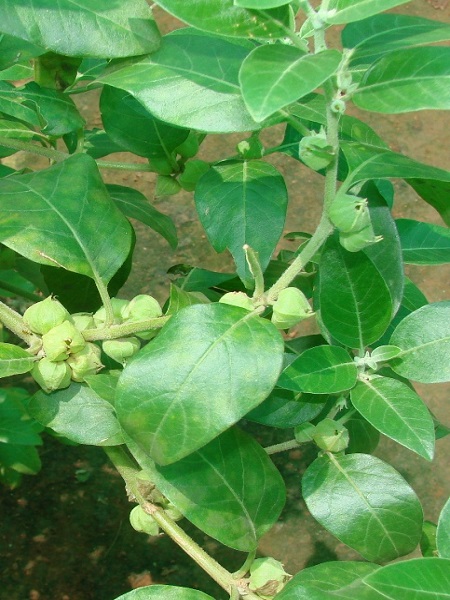
| Family | Solanaceae |
| English Name | Ashwagandha, Asgandh |
| Malayalam Name | Amukkuram |
| Tamil Name | Karappaanthazhai Amukkuram |
| Kannada Name | Angara baeru, ashvagandha, mohini gida |
| Telugu Name | Asvagandhi, dommadolu |
| Hindi Name | asgandh, chirpotan, punir |
| Sanskrit Name | Amukkura, ashvagandha, kushthagandha, rajgandha. |
| Trade Name | Ashwagandha, Asgandh |
| Part Used | Roots and seeds |
| In Wild | Yes |
| Under Cultivation | Yes |
| Temperature | NA |
| Rainfall | 600-750 mm |
| Farmers | NA |
| Traders | NA |
| Institution | NA |
| Individually | NA |
| State/Region | NA |
| District | NA |
| Nursery Information | NA |
| Yield | An average yield from the one-hectare area under commercial cultivation is 0.5- 0.7 tonnes of dried roots and 30- 40 kg seeds |
| Economic of cultivation | Approximate cost of cultivation comes around Rs.25,000/- per hectare. Net return : Up to Rs. 48000/hectare. |
| Quantitative quality standards | • Foreign matter: Not more than 1.0 per cent • Ash: Not more than 8.0 per cent • Acid-insoluble ash: Not more than 2.0 per cent • Alcohol-soluble extractive: Not less than 18.0 per cent • Water-soluble extractive: Not less than 22.0 per cent |
| Description | NA |
| Agro technology/Cultivation practices | 1 stock production: Seeds should to be sown in well-prepared, raised nursery beds. The seeds in the nursery beds are sown in lines spaced at 5 cm and about 1-3 cm deep covered with light soil. The germination commences within 6-7 days of sowing and within ten days from sowing it is complete. 6 weeks old and sufficiently tall seedlings are ready for field planting. 2 Field planting: 6 weeks old seedlings are transplanted at distance of 20-25 cm to 10-15 cm between plants in rows. 30 to 60 plants/m2 or 3 to 6 lakhs plants per hectare 3 Manuring/Fertilization: The Ashwagandha crop does not require heavy doses of manure. 200-300 kg FYM/ha may be applied. 5-6 times vermicompost or FYM may be applied row to row. 4 Irrigation: Light shower after transplantation ensures the establishment of seedlings. There is no need of irrigation if rainfall is at regular intervals. Excessive rainfall/water is harmful to the crop. Lifesaving irrigation may be applied at required intervals. 5 Pests and Diseases: The early stages (seedling stage) of Ashwagandha caused from fungus disease like damping of fungus, seedling blight, seed rotting, die-back etc. Leaf curl tobacco and urtches broom disease were also recognized. |
| Harversting | The crop is ready for harvesting 150 to 180 days after sowing. Maturity of the crop is judged by the occurrence of drying out of leaves and presence of yellow-red berries. The entire plant is uprooted for roots, which are separated from aerial parts by cutting the stem 1- 2 cm, above the crown. The roots are cut transversely into small pieces (7 to 10 cm). The berries are plucked from the dried plants and are threshed to obtain the seeds. |
| Processing | Roots are carefully hand sorted into the following four grades. Grade A: Root pieces 7cm long, 1-1.5cm diameter, brittle, solid, & pure white from outside. Grade B: Root pieces 5cm long, 1cm diameter, brittle, solid and white from outside. Grade C: Root pieces 3-4cm long, less than 1cm diameter and solid. Lower grade: Root pieces smaller, hollow and yellowish from outside. |
| References | NA |

